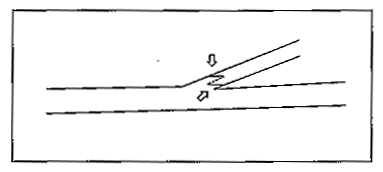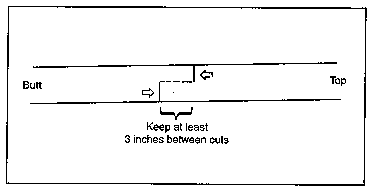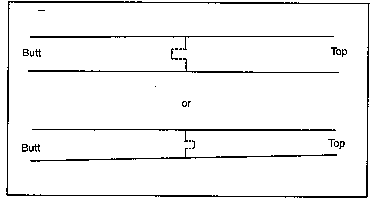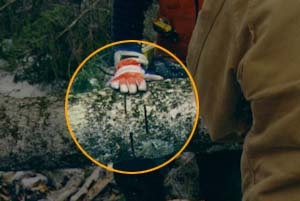Logging eTool
Limbing and Bucking » Examples
Spring Poles:

The safest way to release a springpole is to shave a sufficient amount of wood from the underside of the springpole to allow the wood fiber on the top side to release slowly.
To decide optimum point of springpole release, determine a straight vertical line from the stump to where it meets a straight horizontal line from the highest point of bend, and come down at a 45° angle from where the two lines intersect.
Limb Lock:
Back and sideways pressure on limbs can be handled using a limb lock.

If limbs have back pressure on them, they can severely injure a logger when they are severed from the tree. A good precaution to use in these circumstances is a limb lock. The purpose of a limb lock is to prevent a limb under pressure from kicking back and striking the leg or pinching the saw. The first cut is made on either the topside or bottom side of the limb (top and bottom refer to top and bottom of the limb as if the tree were standing up). It is preferable to make the first cut on the side with compression pressure and the second cut on the side with tension.
The cut on the top of the limb is made closer to the trunk of the tree and the cut on the bottom is made further out on the limb. It is important that the two cuts by-pass so that all fiber is severed. This will create a step in the limb which will prevent the limb from kicking back and hitting the logger.
Top Lock:
Twisting of trees and butts off the ground create pressure on the stem that can be handled with a top lock.


If the stem of the tree is under stress, a top lock can be used to prevent the top from kicking up and striking the logger. The first cut of a top lock is made on the side of the tree that is under compression, in the top or bottom of the stem. The second cut is made on the side of the tree which is under tension. This prevents pinching the saw. The top cut is always made closer to the top of the tree and the bottom cut is made closer to the bottom of the tree (the reverse order of the limb lock). Both cuts must by-pass so that all fiber is severed.
Tongue and Groove:
If there is danger of a tree or portion of a tree rolling on the logger, a tongue and groove can be used. To make the tongue and groove, the stem of the tree is bored in the center. Then up and down cuts are made either closer to the top or butt of the tree, so that each of them by-pass the bore cut, but do not meet. With all fiber severed, the tongue and groove will prevent the tree from rolling.
Loggers using Tongue and Groove cuts to prevent the log from rolling on steep terrain.
Actual log with tongue and groove cuts in it.

Actual log with tongue and groove cut out.


